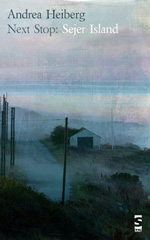

Salt Publishing (UK), paperback, 9781844718702
In Next Stop: Sejer Island, Andrea Heiberg has assembled an endearing cast of characters engaged in the everyday life of their small Danish island. There are eight short stories in this slim volume; seven of them are carefully observed and simply told stories of life in Sejer, where Heiberg lives. Some of the stories appear to be narrated by the author herself, and her presence as a character makes the book seem to be non-fiction. I would not be surprised to learn that actual events have found their way into these tales.
There are no difficult conflicts or terrible events in this book; rather, Heiberg writes affectionately and with gentle humor of how the people of Sejer live and work together, and how they care for one another. A fine example of this is when the venerable 300-year-old schoolhouse burns down, in the story "Never Has There Been A Shade". With the schoolhouse in ashes nearby, the people unite in comforting the distressed schoolmaster by forming an impromptu classroom under an ancient tree and encouraging him to play for them his favorite music on the gramophone that a young man has rescued from the burning building.
The story "Where There is Fish, There is Hope" introduces the new woman pastor, Mary Magdalena, and her husband Anton, a jazz musician. They have just arrived on the island, and are very aware of being considered outsiders in this small community of 400 islanders. Mary Magdalena takes great care in preparing the sermon for her first church service, and hopes to make a good impression on her congregation:
The deep and enduring connections and bonds between people, regardless of their origins or occupations, is another theme of this collection of stories. Later on in "Where There is Fish, There is Hope", a friendship is forged between musician Anton and the weathered fisherman Ernest through music:
'You liked it?'
'I loved it….You also filled my eyes with tears.'
The theme of connections between people is also well illustrated in the story with the unlikely title of "A Kingdom for a Kalashnikov" (this story was featured in Issue 14 of Belletrista). In it, the narrator has hired two workers, immigrants from Afghanistan, to excavate a stone floor in her house so new plumbing can be installed. Before long a neighbor, Helga, joins them, and amid the excitement of finding copper ore under the stone floor, two of the group discover common ground in past tragedies.
In Next Stop: Sejer Island, Andrea Heiberg invites readers to visit the island she calls home. Reading these lovely and thoughtful stories transported me for a brief time to Sejer, and I very much enjoyed the company of the people I met there.
